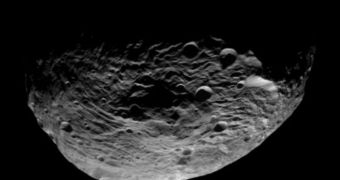Experts managing the NASA Dawn mission announce that the spacecraft was recently able to snap the first images of the asteroid’s South Pole. This space rock is the largest in our solar system to be classified as an asteroid.
Dawn is the first probe ever to enter orbit around an object in the Inner Asteroid Belt (IAB). The formation is located between the orbits of Jupiter and Mars, and is also home to the dwarf planet Ceres. The latter is also a future target for the NASA space explorer.
The spacecraft managed to enter lunar orbit on July 15, after chasing Vesta for more than 4 years. Its main mission is to map the surface of the enormous asteroid, and determine its most important chemical and physical characteristics.
These include how the object was formed, how it evolved, and what stopped its growth during the early days of the solar system. Many experts believe that – if given the proper conditions – this object would have eventually grown into a planet.
The protoplanetary nature of Vesta is one of the most heatedly-debated topics related to the space rock. Dawn was built with the instruments required to put this discussion to rest, one way or another.
The new image the probe relayed back to mission controllers at the NASA Jet Propulsion Laboratory (JPL), in Pasadena California, was collected on July 16, just three days after Dawn managed to achieve a smooth orbital insertion around its target.
JPL experts say that the photo “was taken from a distance of about 6,500 miles (10,500 kilometers) away […]. The smallest detail visible is about 1.2 miles (2.0 km)” wide, they add, quoted by SpaceRef.
Katlenburg-Lindau, Germany-based Max Planck Institute for Solar System Research (MPISSR) build the Dawn framing cameras, that were used to snap these images. The DLR, MPI, JPL and NASA funded the development of the instrument.
The German Aerospace Center (DLR), the Institute of Planetary Research, in Berlin, and the Institute of Computer and Communication Network Engineering, in Braunschweig, were also involved in creating the imaging instrument.

 14 DAY TRIAL //
14 DAY TRIAL //